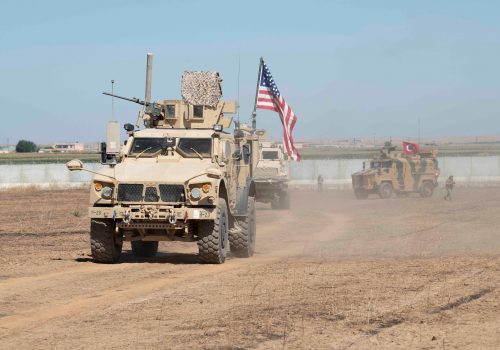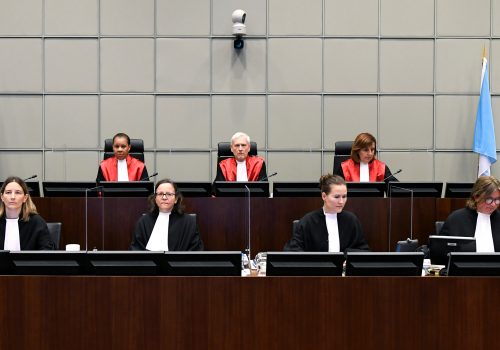Afghanistan demonstrates why it’s time for a clear Syria policy, starting with northeast Syria
Equating the United States’ involvement in Syria to Afghanistan would be a poor comparison. However, for Syrians, the US withdrawal from Afghanistan was a monumental event. For Hay’at Tahrir al-Sham, for example, it was a sign of victory and defeat of a great imperial power while, for the Kurdish-led self-administration—including the Syrian Democratic Council and Syrian Democratic Forces (SDF)—it is a foreshadowing of what may come to pass should the US suddenly withdraw from northeast Syria.
In some ways, though, Syria resembles Afghanistan in that there is no clear US policy. While the US war in Afghanistan started twenty years ago with the initial goal to eliminate al-Qaeda, the justification for its continued presence over the past two decades resembled a shifting goalpost. Indeed, the sudden US withdrawal and immediate Taliban takeover exposed how ill-defined US policy was in Afghanistan.
In Syria, the US has similarly lacked a clear policy since the onset of the conflict over a decade ago, despite providing billions of dollars in humanitarian and stabilization support. The Barack Obama and Donald Trump administrations failed to define what the US hoped to achieve in Syria. Although President Obama approached Syria with strong rhetoric supporting the democratic ideals of the 2011 revolution and calling for Bashar al-Assad’s ousting, he did not take the necessary actions to achieve that goal. President Trump’s lack of a clear and consistent strategy was made all the more evident following his sudden and unilateral withdrawal of the small—but meaningful—US presence in northeast Syria while paving the way for Turkey to take over parts of northern Syria.
Over the years, as the Syrian conflict has lugged on and lost relevance on the international stage, the US continues to struggle to define its Syria strategy. The Joe Biden administration has not yet named a new special envoy to Syria and has played a limited role in its diplomatic engagement in the peace process. Even though the US continues to have a military and diplomatic presence in northeast Syria, it fails to define what it hopes to achieve there beyond vague proclamations of security and stability. Nevertheless, how it will achieve security and stability—and to what end—is the ultimate question. Given the tragic events unfolding in Afghanistan, the US should not make the same mistake in Syria. The United States should develop and define a clear policy for Syria, starting with the northeast region.
Creating a viable US policy for Syria is more challenging than ever before. Syria is not where it was during the Obama administration or even during the Trump administration. The Assad regime has reclaimed large swathes of land—with the help of Iran and Russia—and has shown to be an unrelenting foe that will stop at nothing for a military victory. The political process has transformed from one negotiating for a transitional, credible, and inclusive government, as required under United Nations Security Council Resolution 2254, to a constitutional-drafting exercise that has failed to deliver even the slightest progress in the two years since its initiation.
Indeed, as a testament to how little importance the regime has placed on the political process, Assad was reelected in sham elections with purportedly 95.1 percent of the votes in May. The US-imposed Caesar Act sanctions, meant to lay the foundation for the ousting of the regime, have faced resistance from both regime loyalists and some opposition actors, as living conditions in Syria have deteriorated to the point of near-famine while Assad continues to rule with an iron fist.
Despite this bleak outlook, the US can still play a significant role in Syria, especially in areas where it has a physical presence following the war on the Islamic State of Iraq and al-Sham (ISIS): northeast Syria. Broad proclamations of security and stability should be translated to action plans that can have real and meaningful impacts on the ground. For example, the US should take advantage of its diplomatic relationship with the Kurdish-led authorities to create improved and more politically diverse governance models that are inclusive of local Kurdish and Arab communities—especially in Raqqa and Deir ez-Zor—and provide sufficient space for community leaders, community-based organizations, and activists to operate without fear of detentions or reprisals.
The US can also support the Kurdish-led authorities in building human rights protections, including laws and institutions that provide due process guarantees and safeguards from arbitrary arrests and detentions. Enhancing internal stability and the rule of law can ensure that these areas are not ticking time bombs for dissent or breeding grounds for extremist groups to exploit community grievances. The US should support these areas to become models for other regions and governing bodies in Syria. This can be done through diplomatic pressure on the Kurdish-led authorities combined with clear benchmarks tied to the millions of dollars provided by the US and other donor countries in stabilization funding.
In addition, the US should play a more assertive mediatory role between Turkey and the SDF in Syria. Tensions between Turkey and the SDF have only intensified in recent months following SDF attacks on Turkish-controlled areas in northern Syria and Turkish drone attacks on SDF locations in Syria and the Kurdistan Worker’s Party (PKK) targets in Iraqi Kurdistan, leading to a fear of all-out warfare. Nevertheless, civilians face the brunt of these military actions. Continued escalation will only result in more bloodshed, forced displacements, and demographic changes, and any hopes of regional stability will be lost.
Equally concerning is the possibility of a deal being struck between the Kurdish-led authorities and the Assad regime—placing millions of residents, including dissidents as well as human rights and humanitarian actors—in northeast Syria at tremendous risk. The US should use its physical presence in the region to support de-escalation and long-term regional stability that would benefit both the Kurdish-led authorities and Turkey.
Finally, and equally important, a viable US policy for northeast Syria can translate to increased political leverage on the international stage and during any political settlement. By staying in Syria, the US remains a relevant player and is better able to pressure the Syrian regime, Russia, and Iran for concessions that would benefit Syrians in territories currently under their control. A strategy for northeast Syria should ultimately translate to a more holistic strategy for all of Syria. A sudden withdrawal from northeast Syria, though, would eliminate any possibility of the US mediating necessary political reforms and human rights guarantees in a future Syria.
The US should do everything in its power to protect the lives and livelihoods of the millions in the region by ensuring that, if and when it pulls out of northeast Syria, it has provided sufficient internal and external stability to the region and remained a relevant player in the entirety of the country. If Afghanistan is to teach us anything, the Biden administration should not ignore Syria by having a non-existent policy. The longer the Syrian conflict continues, the more intractable and unmanageable it becomes. It would be a travesty that, after years of involvement and presence in Syria, the US’s only contribution would be to frantically evacuate a small fraction of its allies and partners as millions of civilians are left to uncertain and dangerous fates.
Reem Salahi is a nonresident fellow with the Atlantic Council’s Rafik Hariri Center and Middle East Programs. She focuses on civil society engagement and governance in Syria, accountability, human rights, and international law.
Image: Kurdish People's Protection Units (YPG) fighters stand with their weapons in Tel Hamis in Hasaka countryside March 1, 2015. REUTERS/Rodi Said


